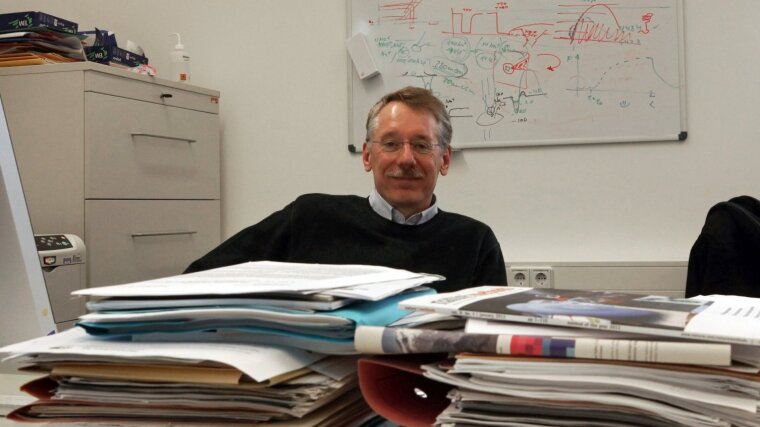
Prof. Dr. Stefan Heinemann
Image: PrivateProf. Dr. Stefan H. HEINEMANN
Email: stefan.h.heinemann@uni-jena.de
Phone: +49 3641-9-395650
Prof. Heinemann is the head of the Department of Biophysics at the Friedrich Schiller University Jena and of the Jena University Hospital. Dr. Heinemann serves as a speaker of the interdisciplinary Research Group FOR 1738 Heme and Heme Degradation Products of the German Research Foundation (DFG). Within ACP, he contributes to research and teaching at the joint meeting point of biomedical sciences and photonics.
The research focus of the Department of Biophysics of the Center for Molecular Biomedicine are ion channels and particularly their modulation by drugs (molecular pharmacology) and cellular redox processes (cellular physiology). By the combination of electrophysiology, molecular biology, and optical technology, we try to elucidate how ion channel activity regulates cellular functions. The overall goal is to understand pathophysiological mechanisms underlying human diseases and to devise strategies for their treatment. Methods applied are single-molecule and single-cell electrophysiological recordings combined with fluorescence microscopy (ratiometric imaging, flash photolysis, optogenetics, confocal laser-scanning microscopy, frequency upconverting nanoparticles).
Research Areas
In his research, Dr. Heinemann focuses on the structure, function and pharmacology of ion channels. In particular, he investigates cellular systems under optical control and uses photonics for targeted cellular manipulations. Research interests include:
- Voltage-gated ion channels
- Cell signaling via redox processes and heme
- Neurotoxins and pain signaling
- Photonic manipulation of living cells
- The biophysics of ion transport
- Frequency upconverting material
Teaching Fields
Dr. Heinemann teaches students at various levels of proficiency – Bachelor‘s degree students in biology and biochemistry, Master‘s degree students in molecular life science and molecular medicine, biochemistry and photonics. He gives courses in:
- The fundamentals of biophysics
- Molecular medicine and pharmacology
- Biomembranes and cellular sensors
- Biophotonics
Research Methods
The laboratories run by Dr. Heinemann offer methods of modern electrophysiology, microscopy, molecular biology and cell physiology including:
- Patch clamp
- Recombinant DNA technology
- Transgenic mice and cell preparations
- Laser scanning microscopy
- Real-time fluorometry and live cell imaging
Recent Research Results
Our Department focuses on the research of ion channels, their structure, function and pharmacology. The function of such membrane proteins can be monitored at real time on a single-molecule level with a combination of molecular biology, electrophysiology and photonic technology. We are studying how ion channels contribute to the function of cells and organs, and are investigating how they can be manipulated by toxins and drugs. The overall aim is to better understand the molecular mechanisms underlying various diseases and to devise therapeutic strategies. An important area of study is the so-called Ca2+- and voltageactivated potassium channel BKCa. It plays important physiological roles in smooth muscle relaxation and in neurotransmitter release. Malfunctions of this channel lead to an array of diseases such as epilepsy, urinary incontinence, and hypertension. Since drugs that open BKCa channels could be useful in disease treatment, we elucidated how low-molecular weight molecules interact with the channel protein to induce conformational changes that finally open the ion-conducting pore. We described the molecular mechanism by which omega-3 fatty acids from oily fish activate BKCa channels [1]. The gating of BKCa is modulated by the surrounding lipid molecules [2]. Further research focuses on how heme and heme degradation products, such as Fe2+ and CO, regulate voltage-gated ion channels. We demonstrated that heme binds to the N-termini of various K+ channel proteins and their beta-subunits that give rise so-called A-type currents [3]. Heme binding interferes with the process of rapid channel inactivation and, therefore, has an impact on cellular electrical signaling. For the detection of free heme in the cytosol, we work on the optimization of fluorescent heme sensors. BKCa channels are also targets of heme; in addition, we showed that Fe2+ is a potent channel activator. Together with partners, we demonstrated how CORM-S1 rapidly releases Fe2+ and CO upon illumination, thus providing access to quantitative studies on Fe2+-mediated gating in a biological setting [4]. Further research areas are related to the photonic modulation of living cells. Based on voltage-gated Na+ channels, we developed gated and ratiometric molecular sensor systems for phototoxicity by incorporating selenocysteine in Na+ channel proteins [5]. Such tools will help to evaluate and control living systems by photonic stimuli. Furthermore, we are studying the photo-electric coupling at cellular plasma membranes as an alternative to optogenetic cellular manipulations, and we develop fluorescent sensors for the measurement of the electrical membrane potential. In collaboration with the Leibniz IPHT Jena, we devise novel approaches for local light generation with molecular targeting of frequency up-converting nanoparticles.
[1] Tian et al., PNAS 113, 13905 (2016).
[2] Tian et al., PNAS 116, 8591 (2019).
[3] Coburger et al., Pflügers Arch. 472, 551 (2020).
[4] Gessner et al., ACS Chem. Biol. 15, 2098 (2020).
[5] Ojha et al., Sci. Rep. 7, 46003 (2017).
